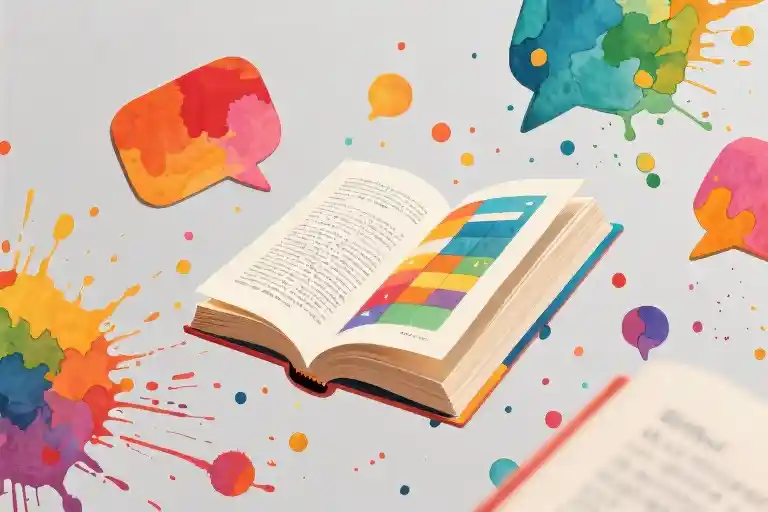Let’s play a game.
I’ll tell you five words I use every day in my country, and you have to guess where I’m from. Ready?
Email, meeting, weekend, goal, feedback.
Not as easy as you’d think, is it? Those words feel so universal, so fundamentally English, that they could belong to anywhere from Tokyo to Buenos Aires. Yet they’re part of my daily vocabulary in a country where English isn’t the native tongue. This linguistic crossover isn’t some academic curiosity—it’s the fabric of modern communication, the subtle evidence of how globalization reshapes our expressions.
The phenomenon of language contact has always existed, but today’s version operates differently. We don’t need conquering armies or colonial administrations to spread vocabulary anymore. English words simply arrive through screens, seep into conversations, and settle into local dialects with surprising ease. They come packaged in business presentations, academic journals, streaming services, and social media feeds—quiet invaders that don’t demand surrender but gradually become indispensable.
What’s fascinating isn’t just that these words travel, but how they become naturalized citizens of other languages. They aren’t marked as foreign anymore; they’re just… words. The Japanese executive scheduling a “meeting,” the German student checking “email,” the Brazilian manager discussing “feedback”—all participating in a global linguistic exchange that’s reshaping how we communicate across cultures.
This isn’t about English “winning” or other languages “losing.” It’s about adaptation, about languages doing what they’ve always done: evolving to meet new needs. When there’s a concept that lacks a perfect local equivalent, or when an English term carries specific professional connotations, borrowing happens naturally. The process reveals much about cultural priorities and practical necessities in our interconnected world.
So where am I from? The answer matters less than the realization that those five words probably sound familiar to you too, regardless of your native language. That shared understanding is the real story here—the quiet, ongoing transformation of how we all communicate.
Language Contact Through the Ages
The words we exchange in daily conversation often carry hidden histories, none more so than those borrowed from distant shores. When William the Conqueror crossed the English Channel in 1066, he brought more than military might—he introduced a linguistic revolution that would forever alter the English language. The Norman French influence seeped into every aspect of life: the Anglo-Saxon “sheep” remained in the fields, but when served at the noble’s table, it became “mutton” (from the French mouton). This division between Germanic-rooted words for common concepts and French-derived terms for refined domains created the rich tapestry of modern English.
Colonial expansion created even more dramatic linguistic transformations. As European powers established territories across Africa, Asia, and the Americas, languages collided with unprecedented intensity. In India, English became the language of administration and education, absorbing countless local words like “bungalow,” “pyjamas,” and “shampoo” while simultaneously implanting its own vocabulary into Hindi, Bengali, and other regional languages. This wasn’t merely word-borrowing; it was the creation of entirely new linguistic ecosystems where grammar structures blended and new hybrid languages emerged.
The mechanisms of language spread have fundamentally shifted from historical patterns. Where once linguistic change required physical conquest or prolonged occupation, today’s language contact occurs through subtler but equally powerful channels. The printing press first accelerated this process, but digital communication has amplified it beyond anything previously imaginable. A new term can circle the globe in hours rather than generations, entering multiple languages simultaneously through social media and streaming platforms.
What distinguishes contemporary language contact from historical examples is the element of choice. The Norman imposition of French was an exercise of power, while today’s adoption of English terms often represents practical adaptation to global interconnectedness. Professionals worldwide use “email” and “meeting” because these concepts emerged alongside technologies and practices that transcended national boundaries. The vocabulary followed the function, creating a shared professional language that facilitates cross-border collaboration without erasing local linguistic identities.
This historical perspective reveals something crucial about language evolution: it has always been messy, unpredictable, and deeply human. Languages don’t respect political boundaries or carefully constructed rules. They flow where people flow, adapt to what people need, and reflect the changing ways we connect with one another. The difference today is the speed and scale of these connections, not their fundamental nature.
Understanding this history helps us see current linguistic changes not as threats to linguistic purity but as continuations of processes that have shaped human communication for centuries. Every language we speak today exists because our ancestors borrowed, adapted, and reinvented the words they encountered. The story of language contact is ultimately the story of human contact—of trade routes and migration patterns, of cultural exchange and technological innovation. It’s the story of how we’ve always found ways to understand each other across divides, using whatever words could bridge the gap.
The Unstoppable Flow of Global Language
Language has always been a living entity, but something fundamentally different is happening now. Where historical language shifts required armies and conquests, today’s linguistic transformations arrive through subtler channels – the glow of smartphone screens, the hum of international conference calls, the shared vocabulary of global platforms that connect us across continents.
English words now weave through other languages with an almost gravitational pull, not because of political dominance but through practical necessity. In boardrooms from São Paulo to Seoul, professionals discuss “deadlines” and “benchmarks” without a second thought. University students in Madrid form “focus groups” while researchers in Tokyo analyze “big data.” The terminology of modern life increasingly speaks with an English accent, regardless of the native tongue surrounding it.
Media consumption patterns reveal this phenomenon most vividly. Streaming platforms have become linguistic delivery systems, carrying English terms directly into living rooms worldwide. When a German teenager binge-watches a British series, they absorb not just the plot but the language patterns. The same occurs when a French executive watches TED Talks or a Indonesian gamer follows English-speaking streamers. These aren’t formal language lessons; they’re cultural osmosis.
Education systems worldwide have embraced English terminology, particularly in higher education and specialized fields. Scientific research papers overwhelmingly publish in English, making terms like “peer review” and “methodology” universal academic currency. Business schools from Mexico to Malaysia teach concepts using their original English labels – “disruptive innovation,” “blue ocean strategy,” “scalability” – because these terms arrive pre-packaged with specific meanings that translations might dilute.
Corporate environments demonstrate perhaps the most practical adoption of English terminology. Multinational companies often adopt English as their official working language, creating hybrid linguistic spaces where German engineers might “troubleshoot” with Brazilian designers about a “user interface bug.” These professional dialects blend native grammar with imported vocabulary, creating what linguists call “business English as a lingua franca” – not perfect English, but perfectly functional communication tools.
Technology represents the most aggressive vector for English language spread. The digital revolution arrived speaking primarily English, and its vocabulary became the default settings for global discourse. From “click” and “scroll” to “algorithm” and “cloud computing,” tech terminology crosses borders with minimal resistance. When new technologies emerge, they often bring their English names along for the ride – consider how “selfie” and “emoji” became global terms almost overnight.
Social media platforms accelerate this process exponentially. TikTok videos, Instagram captions, and Twitter hashtags create micro-environments where language mixing happens organically. A Spanish influencer might caption a post “#goals” while a Japanese user comments “That’s so vibe!” – these platform-native expressions travel across language barriers with ease.
The mechanism behind this digital-age language spread differs fundamentally from historical patterns. Unlike the top-down imposition of language through colonial administration or educational systems, digital language spread is peer-driven and organic. It happens when a Korean teenager adopts the phrase “That’s so random” from watching American YouTubers, or when a Nigerian professional uses “ASAP” in work chats because it’s more efficient than the full phrase in any language.
This linguistic borrowing isn’t about cultural submission but practical adaptation. Languages have always borrowed words to fill lexical gaps, and today’s gaps happen to be forming around global digital culture, international business practices, and technological innovations that often originate in English-speaking environments. The remarkable aspect isn’t that other languages are adopting English terms, but how quickly and seamlessly this process now occurs without any central coordination or formal policy.
What emerges is a fascinating linguistic landscape where code-switching becomes second nature. A Mexican lawyer might draft formal documents in Spanish while peppering internal memos with English terms like “compliance” and “due diligence.” A Russian software developer might think in a blend of English technical terms and Russian grammatical structures. This isn’t language decay but evolution in real-time, responding to the increasingly interconnected nature of our professional and personal lives.
The acceleration mechanisms are built into our digital infrastructure itself. Autocorrect suggestions, search engine algorithms, and translation tools all subtly privilege English terminology, creating feedback loops that reinforce certain vocabulary choices. When a French user types “le weekend” instead of “la fin de semaine,” their phone doesn’t correct them – the technology itself has normalized the borrowing.
This linguistic blending creates fascinating hybrid expressions that reveal how languages adapt rather than simply adopt. Japanese gives us “sararīman” (salaryman), German offers “das Handy” for mobile phone, and Swedish presents “en blogg” for blog. These aren’t pure English terms but linguistic mutations that have been naturalized into their new language homes.
What makes this contemporary language contact phenomenon unique is its democratic nature. Unlike historical language shifts that followed power structures – conquerors imposing language on the conquered – today’s linguistic influences flow through networks of choice and practicality. People adopt English terms not because they must but because these terms serve communicative purposes effectively in an interconnected world.
The implications extend beyond vocabulary into deeper cultural patterns. As business meetings from Milan to Mumbai follow similar agenda structures (“action items,” “next steps,” “key takeaways”), they’re not just sharing words but conceptual frameworks. The language carries with it ways of organizing thought and action that gradually become global defaults.
This isn’t a one-way street either. As English terms flow outward, other languages contribute their own vocabulary to the global pool. The digital world has adopted “emoji” from Japanese, “avatar” from Sanskrit, and “algorithm” from Arabic – reminders that language exchange always operates in multiple directions, even when the flow appears uneven.
The velocity of this linguistic exchange would have been unimaginable even a generation ago. Where loanwords once traveled slowly through printed materials or personal contact, they now spread at network speed. A new slang term coined in Los Angeles can appear in Mumbai conversations within days, adapted and recontextualized through countless cultural filters.
This creates a living laboratory of language evolution that we’re all participating in, whether we realize it or not. Every time we choose an English term over a native equivalent, every time we blend languages in a text message or business presentation, we’re voting in the continuous election that determines how languages grow and change.
What emerges from this process isn’t English triumphing over other languages, but something more interesting: a global linguistic ecosystem where boundaries blur and creativity flourishes. The real story isn’t about one language dominating others, but about how all languages are transforming to meet the needs of a world where communication increasingly ignores national borders.
The Cultural Logic of Borrowed Words
When languages meet, they don’t just exchange pleasantries—they engage in a complex dance of need and opportunity. The borrowing of words across linguistic boundaries represents one of the most natural and organic processes in human communication, driven by the fundamental requirement to express what previously remained unexpressed.
This phenomenon of lexical adoption serves as a linguistic stopgap, filling voids where native vocabulary falls short. Consider the global journey of ‘tofu’—a word that traveled from Japanese kitchens to international supermarkets alongside the food product itself. No language needed to invent a new term for this soybean creation when a perfectly serviceable one already existed in its culture of origin. The adoption was seamless, practical, and ultimately inevitable.
This pattern repeats across domains of specialized knowledge and cultural practice. The world of classical music speaks Italian because the terminology developed alongside the art form in Renaissance Italy. From ‘forte’ to ‘allegro,’ these musical instructions needed no translation—they arrived as complete concepts, packaged in their original linguistic wrapping. Similarly, French culinary terms like ‘sauté,’ ‘julienne,’ and ‘au jus’ crossed borders along with cooking techniques that other cultures hadn’t yet named or perfected.
What makes these borrowings particularly interesting isn’t just their practicality but their cultural baggage. Each borrowed word carries with it traces of its origin story—a subtle cultural imprint that persists even when the word becomes fully naturalized in its new linguistic home. When English speakers use ‘ersatz’ (from German), they’re not just saying ‘substitute’—they’re invoking a particular quality of artificiality that the German term conveys more precisely. When Spanish speakers use ‘footing’ to mean jogging, they’re not just borrowing an English word but adapting it to describe a specific type of recreational running that entered their culture from English-speaking countries.
This process of linguistic borrowing reveals something fundamental about how cultures interact: they take what they need and adapt it to local contexts. The Japanese adopted ‘arubaito’ from the German ‘Arbeit’ (work) to describe part-time jobs, but the term took on specific cultural connotations in its new home. Koreans use ‘service’ to mean ‘complimentary’ or ‘on the house,’ extending the English word’s meaning in ways that reflect local business practices.
Even resistance to borrowing can be culturally revealing. The French Academy’s efforts to create French alternatives to English tech terms—’courriel’ for email, ‘mot-dièse’ for hashtag—demonstrate how language protectionism becomes a form of cultural preservation. Yet these official terms often struggle against the tide of organic usage, suggesting that linguistic evolution follows its own rules, regardless of institutional preferences.
The digital age has accelerated this process exponentially. Technology terms spread at viral speed, often retaining their English forms simply because no localized equivalent emerges quickly enough. ‘Selfie,’ ‘blog,’ and ‘streaming’ have become global vocabulary not through formal adoption but through simultaneous usage across linguistic communities. This represents a new chapter in language contact—one where cultural exchange happens in real-time, across digital networks that respect no national boundaries.
What emerges from this ongoing linguistic exchange is neither cultural domination nor submission, but something more complex: a global vocabulary that reflects our interconnected reality while maintaining local flavors and adaptations. The words we borrow tell stories about what we value, what we lack, and what we’ve discovered from other cultures. They represent not linguistic deficiency but linguistic flexibility—the ability to recognize when another culture has already solved a naming problem we’re just encountering.
This constant flow of vocabulary reminds us that languages aren’t closed systems but living ecosystems that grow through cross-pollination. The beauty of this process lies in its democracy: no language board or government agency controls it. Instead, it unfolds through millions of individual choices—writers choosing the right word, speakers adopting useful terms, communities naturalizing foreign concepts.
As we navigate this landscape of borrowed words, we’re participating in a centuries-old human tradition of cultural exchange through language. Each adopted term represents a small bridge between cultures—a point of connection that enriches both the borrowing and the lending language. In this sense, every loanword tells two stories: one about the concept it describes, and another about the human connections that made its journey possible.
The New Rules of Language Contact
What makes our current era of linguistic exchange fundamentally different from historical patterns is the absence of forced imposition. Unlike the Norman Conquest that brought French vocabulary to English through military dominance, today’s language contact occurs through voluntary adoption and cultural fascination. This represents a significant shift in how languages interact—from top-down imposition to bottom-up embrace.
The digital landscape has become the primary catalyst for this new mode of language fusion. Social media platforms, streaming services, and global news outlets create continuous cross-border conversations where words travel at unprecedented speeds. When a new tech term emerges in Silicon Valley, it might appear in Tokyo startups and Berlin tech hubs within days, not decades. This acceleration transforms language from a slow-evolving system to a dynamic, real-time exchange.
What’s particularly fascinating is the bidirectional nature of modern language influence. While English contributes business and technology terms globally, other languages send their cultural exports through food, entertainment, and lifestyle concepts. The Korean word “hallyu” (Korean wave) now appears in international media discussions, while “hygge” from Danish and “lagom” from Swedish have found homes in English lifestyle vocabulary. This reciprocal exchange creates a richer linguistic tapestry where no single culture dominates unilaterally.
Digital platforms don’t just accelerate word adoption—they transform how we experience language contact. TikTok videos teach Japanese phrases to Brazilian teens, Spanish cooking tutorials introduce culinary terms to Australian home chefs, and K-pop lyrics make Korean expressions familiar to listeners worldwide. This multisensory, engaging format makes language learning incidental and enjoyable, breaking down the barriers that once made foreign vocabulary seem intimidating or irrelevant.
The voluntary aspect of contemporary language borrowing reflects deeper cultural shifts. People adopt foreign words not because they’re forced to, but because these terms represent concepts, products, or experiences they value. The German word “Fernweh” (longing for far-off places) resonates in our increasingly mobile world, while the Japanese “tsundoku” (acquiring reading materials but letting them pile up) perfectly captures a modern digital behavior. These terms fill lexical gaps while connecting us to global experiences.
This new paradigm of language contact creates interesting questions about cultural identity and linguistic purity. As boundaries blur, some worry about language homogenization, while others celebrate the creative possibilities of hybrid expressions. The reality is more nuanced—languages have always borrowed and adapted, but now they do so with greater awareness and choice. The words we incorporate into our daily speech increasingly reflect our multiple affiliations and global connections.
Understanding these mechanisms helps us navigate cross-cultural communication with more sensitivity and awareness. Recognizing why certain words cross borders while others don’t reveals much about what different cultures value and share. It reminds us that language contact isn’t about domination or loss, but about the continuous human need to find words for new experiences and connections—whether they come from across the ocean or across the digital divide.
The Practical Wisdom of Cross-Cultural Communication
When we notice English words appearing in other languages, it’s not merely a linguistic curiosity—it’s an invitation to understand how people across cultures actually communicate. The real value lies not in cataloging these borrowed words, but in recognizing what they reveal about human connection.
Language learning transforms when we approach it as cultural exploration rather than vocabulary acquisition. Those English terms embedded in other languages often point to concepts that didn’t previously exist in that culture, or to areas where cultural exchange is most active. Instead of just memorizing words, we might ask: Why did Japanese adopt “rimōto kontorōrū” (remote control) rather than create a native term? What does that tell us about technology’s rapid integration? This perspective turns language study from a mechanical exercise into a continuous discovery of how cultures meet, blend, and influence one another.
In business contexts, linguistic awareness becomes practical wisdom. Notice how “deadline” and “brainstorming” have entered numerous languages unchanged. Their adoption suggests shared workplace concepts that transcend cultural boundaries. Yet the real skill isn’t just recognizing these words—it’s understanding when to use them and when to seek native equivalents. Sometimes using the borrowed term creates instant understanding; other times, it might come across as culturally insensitive. The most effective communicators develop a sensitivity to these nuances, recognizing that language borrowing isn’t uniform across industries, generations, or social contexts.
We can all become observers of this linguistic landscape. Start by paying attention to the English words that appear in your own language’s advertisements, technology terms, or business conversations. Notice which concepts get borrowed and which get translated. Observe how younger generations might use these terms differently than older speakers. These observations aren’t just academic—they’re practical tools for navigating our increasingly connected world.
The beauty of this phenomenon is that it gives us visible markers of cultural exchange. When we see English words in other languages, we’re seeing the living process of globalization in action. And when we notice words from other languages enriching English—think “karaoke,” “emoji,” or “wanderlust”—we’re reminded that this exchange flows both ways. This awareness helps us move beyond seeing languages as separate systems and instead appreciate them as constantly evolving expressions of human creativity and connection.
What makes this perspective particularly valuable is its humility. It acknowledges that no single language has all the answers, and that communication often works best when we’re willing to borrow, adapt, and create together. The practical takeaway isn’t a set of rules, but rather an attitude of curiosity and respect—the understanding that every linguistic exchange represents people trying to connect across boundaries, and that sometimes the most effective communication happens in the spaces between languages.
A Tapestry of Words
Take a moment to listen to the language around you—really listen. That conversation at the next table, the advertisement on your screen, the instructions for your new appliance. How many borrowed words do you hear woven into the fabric of your native tongue? We’ve explored how languages meet and mingle through conquest, colonization, and now through the quiet revolution of globalization. But this isn’t just historical curiosity or linguistic theory—it’s happening in your life, right now, in the words you choose without thinking twice.
You might notice English terms popping up in your workplace meetings, even when everyone speaks the same native language. Technical terms, business jargon, or even casual phrases like “let’s deadline this” or “I’ll email you” have become so naturalized we rarely question their origins. This isn’t about language purity or corruption; it’s about communication finding its most efficient path, much like water finding its way through stone.
What fascinating borrowings have you encountered? Perhaps you’ve ordered a “cappuccino” in Tokyo, discussed “feng shui” in London, or heard someone in Madrid talk about their “weekend plans.” These cross-cultural exchanges create invisible threads connecting us across continents. They’re evidence of our shared human experience, showing how we adapt and adopt what serves us while maintaining our unique linguistic identities.
I’d love to hear what you’ve noticed in your own linguistic environment. What words have traveled into your language recently? Which ones feel natural, and which still carry the faint accent of foreignness? Share your observations—not as a linguistic expert, but as someone who lives and breathes language every day. Your perspective adds another thread to this rich tapestry of global communication.
Remember, language diversity isn’t about building walls between tongues but about celebrating the bridges we build naturally. Each borrowed word represents a moment of cultural contact, an idea that was too useful or beautiful to leave behind. They remind us that languages, like cultures, thrive not in isolation but in conversation with one another.
As you go about your days, keep an ear open for these linguistic travelers. Notice how they’ve made themselves at home in new contexts, how they’ve been shaped by their new environments even as they transform them. This awareness won’t just make you a better language learner or communicator—it will deepen your understanding of how we all, across this beautifully diverse world, find ways to understand each other.
Our languages are living, breathing records of our encounters, our innovations, and our shared humanity. They remind us that while we may speak different tongues, we’re all engaged in the same fundamental human project: trying to connect, to understand, and to be understood. And that’s something worth celebrating in any language.





